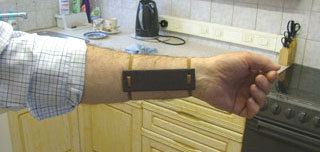 | ||
Early Bronze Age stone wrist-guards are found across Europe from around 2400-1900 BC and are closely associated with the Beaker culture and Unetice culture. In the past they have been variously known as stone bracers, stone arm-guards and armlets, although "stone wrist-guard" is currently the favoured terminology; and it's no longer thought that they were functional archer's bracers.
Contents
Description
The wrist-guards are small rectangles of stone (often slate) with a number of perforations, typically between two and six, which might allow attachment to the arm with cord. One, from Hemp Knoll in Wiltshire, had markings which clearly indicate its attachment to the arm by two cords. The shapes of the wrist-guard are stereotyped and common forms exhibit a narrowed 'waist' and curved cross-section (presumably so they fit the arm better).
Stone wrist-guards are exclusively found in the graves of males, often lying next to the corpse's wrist. Rare examples - three in Great Britain - use rare imported greenstone and are decorated with gold-capped rivets or foil, clearly representing an elite form. The three British examples are from burials at Driffield, Barnack and Culduthel Mains in Scotland.
Original use
It was originally thought that these stone wrist-guards were bracers, used by archers to protect their bow arms from the string of the bow. However, recent research has highlighted that (in Britain at least) they do not commonly occur in graves in association with arrowheads (the Amesbury Archer being a notable exception), nor are they commonly found on the part of the arm that would need protection from the bowstring (on a right-handed archer, the inside left wrist). They are usually found on the outside of the arm where they would have been more conspicuous. Many have only two holes which would make them difficult to fasten securely to the arm, and some have projecting rivets which would catch on the bowstring and make them unsuitable for use as a bracer.
When the objects occur in barrows, they always occur in the central primary grave, a place thought to be reserved for heads of family and other important people. Many show great skill in polishing and stone working, and few are found in areas from which their stone originates. It seems likely that, as found in graves, these objects were used as symbols of status within family groups. They may have been status symbols of prowess in hunting or war, possibly mounted as decorations on functional bracers. However, one at least (from Barnack in Cambridgeshire) had pressed foil caps in each of its 18 holes. These caps would have prohibited any form of rivet or cord being used as a means of attachment. A few prehistoric wrist-guards made of gold or amber have also been found; these are generally accepted not to be functional.
Famous burials containing stone wrist-guards include the Amesbury Archer and Barnack Burial.
Terminology
The wrist-guards are commonly classified following either the 1970 Atkinson classification (cited in Clarke 1970) or the 2006 Smith classification. Of the two it is the 2006 Smith classification which is less rigid and more descriptive. It uses a three-character system to classify the objects on three simple characteristics:
Total number of perforations: (e.g. 2, 4, 6 etc.)
Shape in plan: described as-
Shape in transverse cross-section: described as-
The most common types of wrist-guard are the 'tapered variety' consisting of 2TFs, 'straight variety' consisting mainly of 4SFs and 6SFs and the 'waisted variety' consisting mainly of 4WCs
This is how the 1970 Atkinson classification translates into the newer classificatory system:
A1 = 2TF
A2 = 2TF
B1 = 2SF
B2 = 4SF
B3 = 6SF
C1 = 4WC
C2 = 2WC
